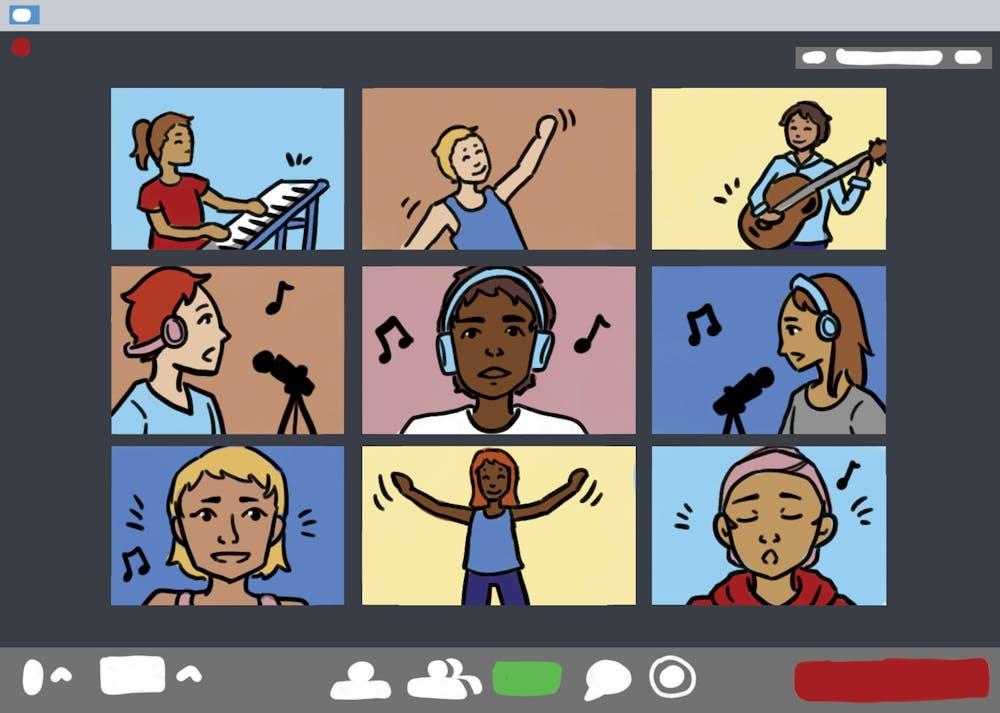Since the start of the pandemic, the question of how to create live theater in a virtual environment has been on the minds of almost every theater artist around the globe.
You could follow the "Hamilton" model and release recordings of a show from before the pandemic, but it still lacks live performance, putting companies back at square one.
This conundrum has led some companies to embrace the format of virtual readings, using platforms like Zoom to tell stories from the comfort of the actors' homes.
Although not a new practice, virtual readings have become a staple of pandemic theater, being embraced by groups like StarKid Productions, the masterminds behind musicals like "A Very Potter Musical" and "Firebringer" (the latter being the source of the viral “I don’t really wanna do the work today” meme from 2016).
Beginning in October 2020, the group launched "Nightmare Time," a series of streamed, virtual readings taking place within the shared horror-comedy continuity of two of their previous productions — "The Guy Who Didn't Like Musicals" and "Black Friday."
Similar to "Nightmare Time" is the viral "Ratatouille" musical which streamed early 2021 as a fundraiser for The Actor's Fund. Starting as a trend on TikTok, the production evolved from meme to musical, complete with a cast of Broadway veterans.
While these efforts capitalize on the widespread popularity of Zoom, some creators, such as music theater performance lecturer Toby Yatso, find these types of productions to still be lacking.
"Some virtual streaming, Zoom things that I tuned into, depressed me more than they fulfilled me," Yatso said. "And so, throughout the second half of 2020, I consumed limited amounts of virtual theater."
For Yatso, an experienced performer and artist-in-residence for the Phoenix Theatre Company, the limitations created by the pandemic provided the perfect chance to experiment with the virtual form, putting his efforts into ASU's production of the 1978 musical "Runaways" by Elizabeth Swados, which streamed from March 12-14.
This unique show, directed by Yatso, combines jazz, rock, pop and folk music from multiple cultures to craft a fragmented story of kids and teens who ran away from home, based on true stories. A hybrid of scenes shot on set at the Tempe campus and individually filmed vignettes crafted by actors, the production was a complicated process Yatso said was no easy undertaking.
"Our phrase for the whole experience was 'we're building the plane as we fly it,'" he said. "We all needed to be in, across the board, from cast, to crew, to directors, leadership, everybody. And everyone stepped into that so beautifully."
For Yatso and his creative team of music director Mario Yniguez and choreographer Hannah Victoria Thomas, the appeal of "Runaways" rested in both the size of the production and the diverse ensemble cast, made up of actors from various backgrounds.
The virtual format allowed Gregory Oxley, a junior studying technological entrepreneurship and management who is deaf, to contribute his talents from his home in Washington.
"(Oxley) was never in Tempe for the whole thing. All of his rehearsals were over Zoom with an interpreter, and we worked on all of his ASL scenes," Yatso said. "He ended up making his own videos in Seattle, and then sending them to us and we edited it together to be a part of the whole program."
Despite the massive effort put into this production, the pre-recorded nature of it led Yatso to believe it still lacks the live aspect of theater that so many artists are still seeking.
READ MORE: Pandemic casts spotlight on evolving theater industry
"I have to admit that what we made was a film," he said. "I'm not a movie maker. I'm a theater artist who dabbled in movie making with other talented people who were dabbling in moviemaking with me."
But Yatso said he thinks there's still is a way to reproduce the true live experience in a virtual environment, pointing specifically to ASU's production of "Heddatron," which was performed mostly live from multiple different locations and streamed online. With just a little bit of improvement, Yatso believes this format could be just what virtual theater needs.
"That sort of excitement of 'you had to be there to experience it' is that," he said. "'Runaways' was not that at all."
While theater seems to be staying virtual for the foreseeable future, its efforts like Yatso’s work on "Runaways" that help pave the way to keep the art alive.
Reach the reporter at nmdelga3@asu.edu and follow @DelGoada on Twitter.
Like The State Press on Facebook and follow @statepress on Twitter.
Continue supporting student journalism and donate to The State Press today.




